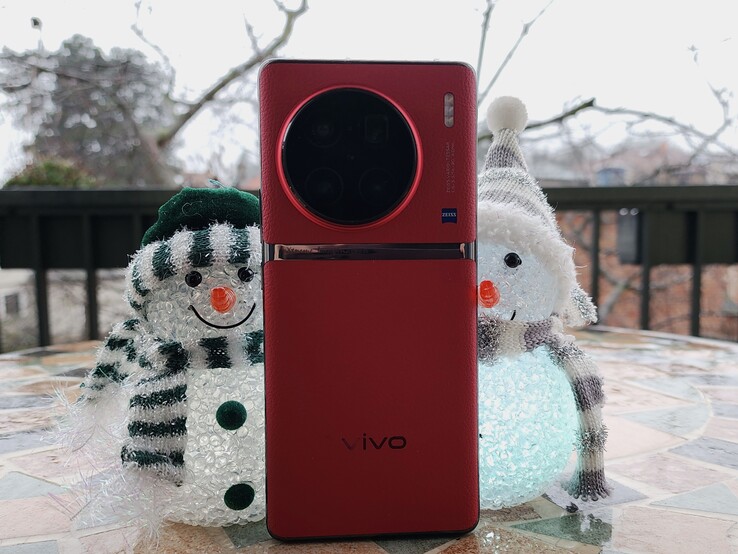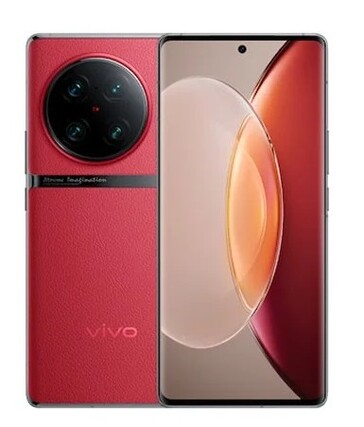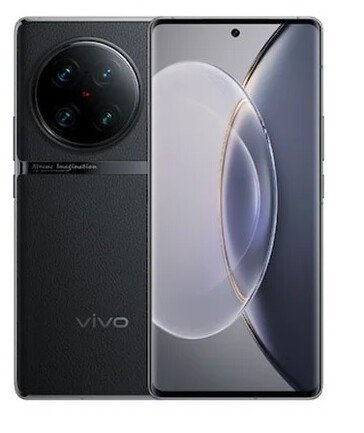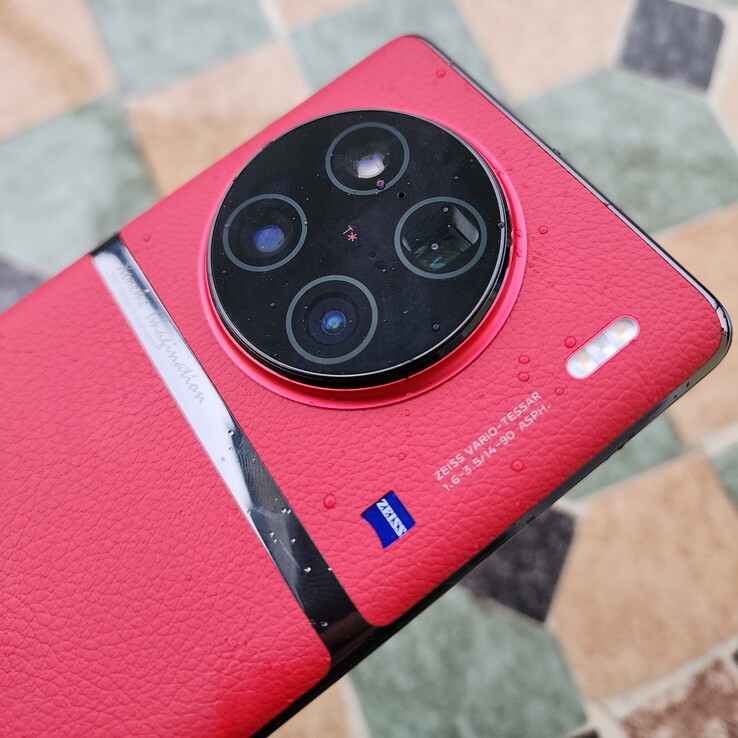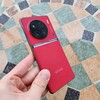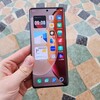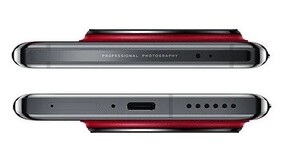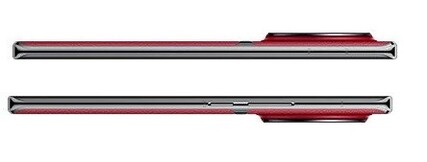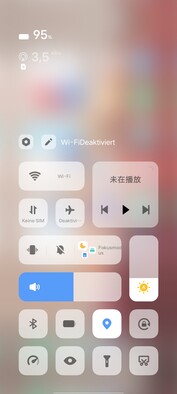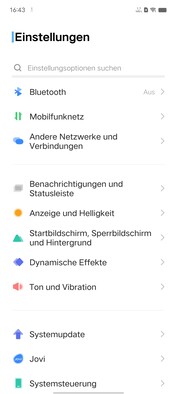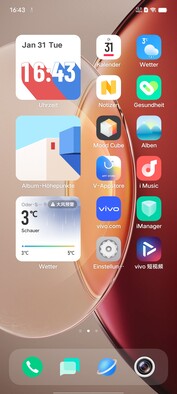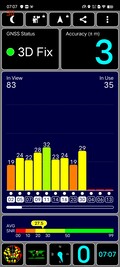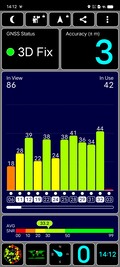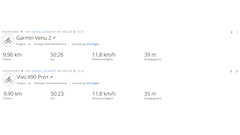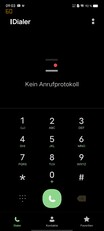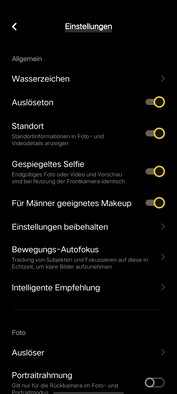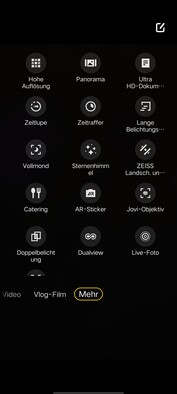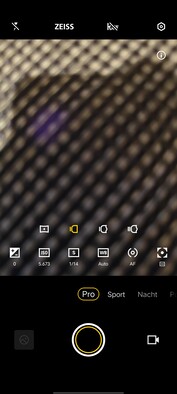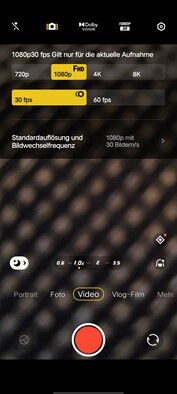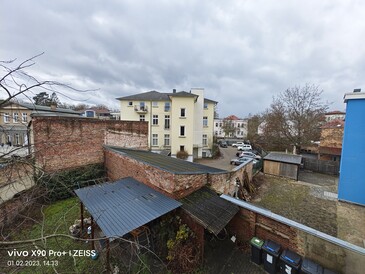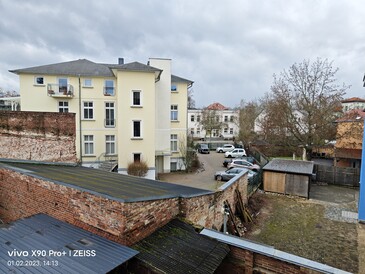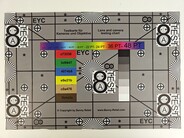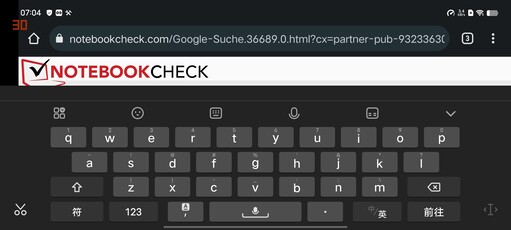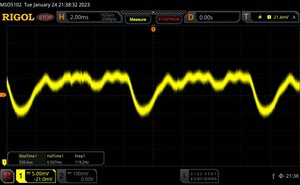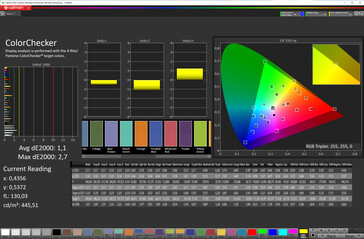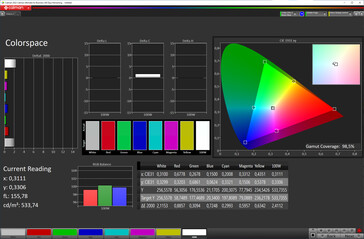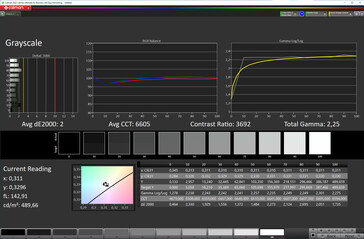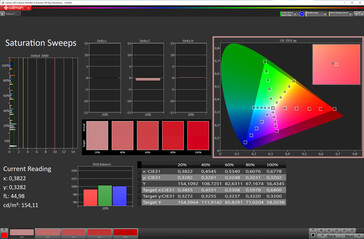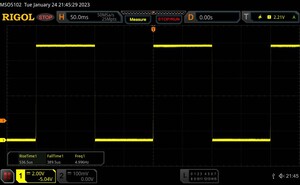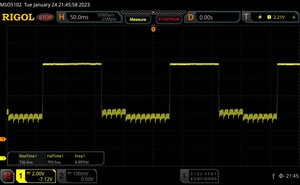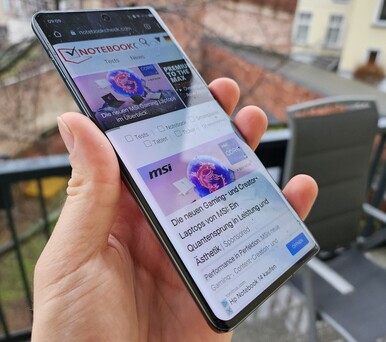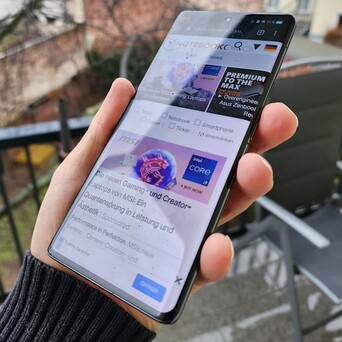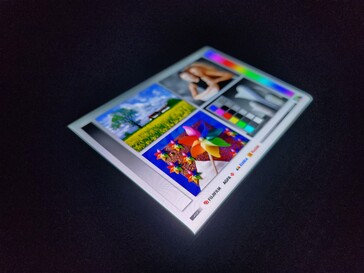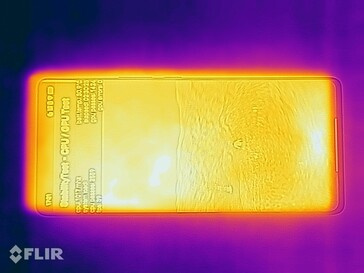Vivo X90 Pro+ Review: Vivo sets the bar very high with its flagship smartphone
Last November, Vivo officially launched its X90 smartphone series in China, including X90 Pro+ as the flagship. The X90 Series can be purchased via import, but there are signs of global availability in the near future. However, this would be without the Pro+ variant, which, as in the previous year, will not be released on the European market.
The X90 Pro+ has a strong set of features befitting a flagship smartphone. Vivo uses a 120 Hz 1,440p+ AMOLED panel with a peak brightness of 1,800 nits and the Qualcomm Snapdragon 8 Gen 2 SoC. The Vivo X90 Pro+ also really trumps in the camera setup with Sony's IMX989 — a 1-inch image sensor.
Possible competitors in comparison
Rating | Date | Model | Weight | Drive | Size | Resolution | Best Price |
|---|---|---|---|---|---|---|---|
| 90 % | 02/2023 | Vivo X90 Pro+ SD 8 Gen 2, Adreno 740 | 221 g | 256 GB UFS 4.0 Flash | 6.78" | 3200x1440 | |
| 89.4 % | 03/2022 | Samsung Galaxy S22 Ultra 5G Exynos 2200, Xclipse 920 | 228 g | 128 GB UFS 3.1 Flash | 6.80" | 3088x1440 | |
| 89.1 % | 02/2023 | Xiaomi 13 SD 8 Gen 2, Adreno 740 | 189 g | 256 GB UFS 4.0 Flash | 6.36" | 2400x1080 | |
| 89.1 % | 11/2022 | Google Pixel 7 Pro Tensor G2, Mali-G710 MP7 | 212 g | 128 GB UFS 3.1 Flash | 6.70" | 3120x1440 | |
| 88.5 % | 09/2022 | Vivo X80 Pro SD 8 Gen 1, Adreno 730 | 215 g | 256 GB UFS 3.1 Flash | 6.78" | 3200x1440 |
Case: Vivo smartphone with punch hole
The casing of the X90 Pro+ is made of Gorilla Glass Vicutus, an aluminum frame, and vegan leather back. The X90 Pro+ feels very premium in the hands, and the 90% screen-body ratio is possible thanks to the narrow edges around the OLED panel. There are hardly any distracting edges on the sides due to the curved display.
The build quality of our review sample is first-rate, and the X90 Pro+ also comes with an official IP68 certification. Thus, the casing is both dust and waterproof.
Equipment: Vivo X90 Pro Plus with UFS 4.0
The X90 Pro+ is available in two different versions (12 GB + 256 GB and 12 GB + 512 GB). The internal UFS 4.0 storage has a capacity of 256 GB in our review sample, but the user only gets about 219 GB of free space in the state of delivery. If the storage is not enough, you will have to buy the larger storage SKU because the Vivo flagship does not support expansion via micro-SD cards.
Other features include Miracast, Bluetooth 5.3, and NFC including Google Pay (a Play Protect certification is available). Peripherals, such as a memory stick, can be connected via the USB-C port using an OTG adapter. The USB interface's data transfer is based on the 3.2 Gen1 standard.
Software: Vivo X90 Pro+ comes with Android 13
The X90 Pro+ is not based on the Funtouch OS that is common with Vivo phones but on the Chinese equivalent called Origin OS. The UI is based on Android 13 but is strongly adapted to the Chinese market.
Nevertheless, many languages including German, can be selected. Even Google Services can be activated easily, so the Google Play Store and other Google apps can be used relatively smoothly. Streaming content in high resolution is also possible thanks to the Widevine L1 certification.
Origin OS 3 came with December 2022 security patches at the time of testing. How long does Vivo plan to support the X90 Pro+ with OS upgrades and security updates is not yet officially known.
Communication and GNSS: Vivo X90 Pro+ with Wi-Fi 6
The X90 Pro+ supports access to the mobile 5G network and a wide range of 4G frequencies. The Vivo phone can access a total of 22 LTE bands, including bands 20 and 28.
The flagship phone offers fast Wi-Fi 6 within the domestic WLAN, which is sufficient for average transfer rates of over 900 Mbps in combination with our Asus ROG Rapture GT-AXE11000 reference router, but the 6 GHz frequency range (Wi-Fi 6E) is missing.
| Networking | |
| iperf3 receive AXE11000 | |
| Vivo X80 Pro | |
| Vivo X90 Pro+ | |
| Google Pixel 7 Pro | |
| Xiaomi 13 | |
| Samsung Galaxy S22 Ultra 5G | |
| Average of class Smartphone (34.8 - 1875, n=210, last 2 years) | |
| iperf3 transmit AXE11000 | |
| Vivo X80 Pro | |
| Vivo X90 Pro+ | |
| Google Pixel 7 Pro | |
| Xiaomi 13 | |
| Average of class Smartphone (40.5 - 1810, n=211, last 2 years) | |
| Samsung Galaxy S22 Ultra 5G | |
| iperf3 transmit AXE11000 6GHz | |
| Xiaomi 13 | |
| Samsung Galaxy S22 Ultra 5G | |
| Google Pixel 7 Pro | |
| Average of class Smartphone (229 - 1894, n=61, last 2 years) | |
| iperf3 receive AXE11000 6GHz | |
| Google Pixel 7 Pro | |
| Samsung Galaxy S22 Ultra 5G | |
| Xiaomi 13 | |
| Average of class Smartphone (598 - 1840, n=61, last 2 years) | |
Telephony and voice quality: Vivo smartphone with dual-SIM
The dual-SIM smartphone from Vivo supports VoLTE, and calls are also allowed via the home Wi-Fi (Wi-Fi calling). Like the X80 Pro, the current flagship lacks eSIM support.
The voice quality does not pose any surprises, and the installed microphones transmit the voice intelligibly to the caller. Video calls via the built-in front-facing camera and the built-in speaker via the Skype app also worked without problems in the test.
Cameras: Vivo X90 Pro+ with Sony IMX989
The X90 Pro+, along with cooperation from Zeiss, combines a 50 MP main camera based on the Sony IMX989 sensor along with a 48 MP ultra-wide-angle lens, a 50 MP portrait camera, and a 64 MP periscope telephoto lens.
The heart of the camera unit, the large 1-inch Sony sensor, offers really good shots in daylight as well as at night. The photos have a wide dynamic range, but there are also weaknesses in sharpness levels from time to time. The Vivo phone can also convince in terms of color reproduction, but the X90 Pro+ often captures the subjects quite cool.
We also measured low DeltaE deviations in the ColorChecker under controlled lighting conditions, with the exception of green tones.
Besides the solid ultra-wide-angle camera, which is actually the weakest lens in the camera quartet, the Vivo X90 Pro+ also has excellent zoom qualities. Especially at 5x lossless magnification, the X90 Pro+ preserves a lot of details. Even the 100x zoom is quite usable.
Image Comparison
Choose a scene and navigate within the first image. One click changes the position on touchscreens. One click on the zoomed-in image opens the original in a new window. The first image shows the scaled photograph of the test device.
HauptkameraHauptkameraLow LightUltraweitwinkelZoom 5x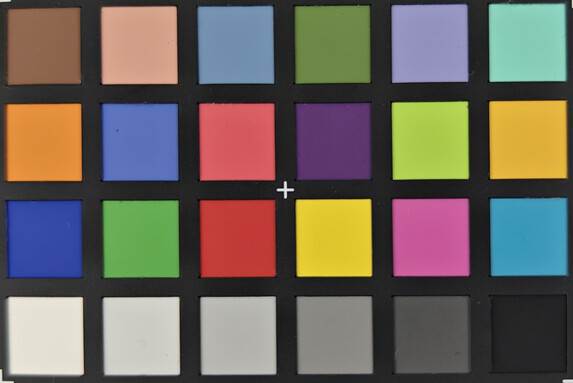
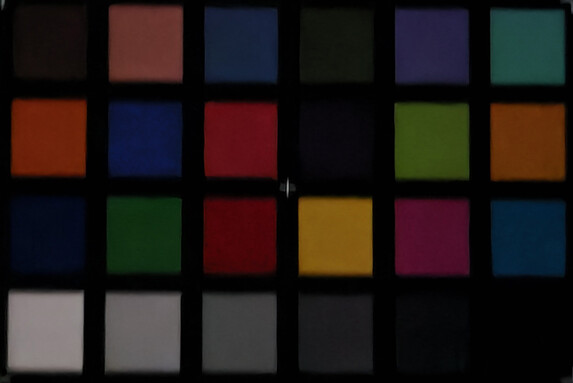
Accessories and warranty: Vivo X90 Pro+ comes with a power adapter
The scope of delivery consists of a USB cable, a very high-quality protective case, and a modular 80 W CN power supply. TradingShenzhen also includes an EU adapter for the sockets used in this country, but this is not part of the standard scope of delivery and is a service of the lender.
The warranty is 12 months. Our review sample from TradingShenzhen also offers the option of sending the X90 Pro+ to a German shipping address in case of a warranty claim.
Input devices and operation: Vivo phone with huge fingerprint sensor
Thanks to the high refresh rate up to 120 Hz, even fast scrolling passages are displayed smoothly. The huge ultrasonic fingerprint sensor underneath the OLED panel is not only one of the fastest on the market but is also reliable for detecting two fingers in parallel.
The Qualcomm 3D Sonic Ultrasonic sensor is clearly a unique selling point for the flagship. A relatively insecure 2D FaceUnlock feature is also on board.
Display: Vivo X90 Pro Plus with OLED
The X90 Pro+ has a 6.78-inch LTPO AMOLED display with a high resolution of 3200 x 1440 pixels and supports an adaptive refresh rate of up to 120 Hz — we could read a minimum frequency of 5 Hz from the system in the test.
In terms of brightness, illumination and sharpness, the Vivo flagship can convince all along by achieving an average brightness of over 1,100 cd/m² in a full white display. In the APL18 measurement, we find the brightness to be 1,614 cd/m² in the center of the screen. Thus, the panel is very well suited for reproducing HDR content.
Due to the OLED technology, the Vivo phone is not spared from screen flickering. Below a display brightness of 43%, the PWM frequency fluctuates around the native refresh rate of 120 Hz (66 to 222 Hz). Above this brightness setting, the PWM increases up to 706 Hz. Using DC dimming (anti-fatigue mode), the flickering amounts to a constant 120 Hz.
| |||||||||||||||||||||||||
Brightness Distribution: 96 %
Center on Battery: 1109 cd/m²
Contrast: ∞:1 (Black: 0 cd/m²)
ΔE Color 1.1 | 0.5-29.43 Ø5
ΔE Greyscale 2 | 0.57-98 Ø5.3
100% sRGB (Calman 2D)
Gamma: 2.25
| Vivo X90 Pro+ AMOLED, 3200x1440, 6.78 | Samsung Galaxy S22 Ultra 5G Dynamic AMOLED, 3088x1440, 6.80 | Xiaomi 13 OLED, 2400x1080, 6.36 | Google Pixel 7 Pro OLED, 3120x1440, 6.70 | Vivo X80 Pro AMOLED, 3200x1440, 6.78 | |
|---|---|---|---|---|---|
| Screen | 8% | -1% | 12% | 9% | |
| Brightness middle | 1109 | 1077 -3% | 1209 9% | 1022 -8% | 938 -15% |
| Brightness | 1124 | 1093 -3% | 1208 7% | 1025 -9% | 947 -16% |
| Brightness Distribution | 96 | 97 1% | 98 2% | 99 3% | 97 1% |
| Black Level * | |||||
| Colorchecker dE 2000 * | 1.1 | 1.2 -9% | 1.2 -9% | 0.9 18% | 0.9 18% |
| Colorchecker dE 2000 max. * | 2.7 | 2 26% | 3 -11% | 2.1 22% | 1.9 30% |
| Greyscale dE 2000 * | 2 | 1.3 35% | 2.1 -5% | 1.1 45% | 1.3 35% |
| Gamma | 2.25 98% | 2.37 93% | 2.26 97% | 2.22 99% | 2.2 100% |
| CCT | 6605 98% | 6526 100% | 6504 100% | 6650 98% | 6518 100% |
* ... smaller is better
Screen Flickering / PWM (Pulse-Width Modulation)
| Screen flickering / PWM detected | 222 Hz | ||
The display backlight flickers at 222 Hz (worst case, e.g., utilizing PWM) . The frequency of 222 Hz is relatively low, so sensitive users will likely notice flickering and experience eyestrain at the stated brightness setting and below. In comparison: 53 % of all tested devices do not use PWM to dim the display. If PWM was detected, an average of 17900 (minimum: 5 - maximum: 3846000) Hz was measured. | |||
Measurement series with fixed zoom level and different brightness settings
We examine the OLED panel's color calibration using the Calman analysis software. The quite large DCI-P3 color space is controlled in the factory settings. Besides the Zeiss mode, three other modes are also available. Our measurement with the spectrophotometer results in very low average Delta-E deviations of 1.1 (colors) and 2.0 (grayscale) for the Zeiss profile.
Display Response Times
| ↔ Response Time Black to White | ||
|---|---|---|
| 0.93 ms ... rise ↗ and fall ↘ combined | ↗ 0.5365 ms rise | |
| ↘ 0.3895 ms fall | ||
| The screen shows very fast response rates in our tests and should be very well suited for fast-paced gaming. In comparison, all tested devices range from 0.1 (minimum) to 240 (maximum) ms. » 1 % of all devices are better. This means that the measured response time is better than the average of all tested devices (21.5 ms). | ||
| ↔ Response Time 50% Grey to 80% Grey | ||
| 1.44 ms ... rise ↗ and fall ↘ combined | ↗ 0.736 ms rise | |
| ↘ 0.7055 ms fall | ||
| The screen shows very fast response rates in our tests and should be very well suited for fast-paced gaming. In comparison, all tested devices range from 0.2 (minimum) to 636 (maximum) ms. » 3 % of all devices are better. This means that the measured response time is better than the average of all tested devices (33.7 ms). | ||
Performance: X90 Pro Plus with Qualcomm SoC
As expected from a 2023 flagship, the X90 Pro+ relies on a powerful SoC, namely the Snapdragon 8 Gen 2. The Kryo CPU consists of four clusters with different architectures. A fast Cortex-X3 prime core (3.2 GHz) as well as two Cortex-A715 (2.8 GHz) and two Cortex-A710 cores provide very high results in our benchmarks, especially in Geekbench multi-core. However, the achieved scores are a bit below the Xiaomi 13.
Also in the graphics workloads, which are performed by the Adreno 740, the Vivo X90 Pro+ performs very well while the Xiaomi 13 performs about 10 to 15% better.
Thanks to the SoC's high performance and fast UFS 4.0 memory, there are no noticeable lags in everyday use and the system runs smoothly. The same is true for browsing in the Chrome browser, although the benchmarks are quite low.
| UL Procyon AI Inference for Android - Overall Score NNAPI | |
| Vivo X80 Pro | |
| Google Pixel 7 Pro | |
| Average of class Smartphone (207 - 84787, n=150, last 2 years) | |
| Vivo X90 Pro+ | |
| Xiaomi 13 | |
| Average Qualcomm Snapdragon 8 Gen 2 (11338 - 16880, n=16) | |
| Samsung Galaxy S22 Ultra 5G | |
GFXBench (DX / GLBenchmark) 2.7: T-Rex Onscreen | 1920x1080 T-Rex Offscreen
GFXBench 3.0: on screen Manhattan Onscreen OGL | 1920x1080 1080p Manhattan Offscreen
GFXBench 3.1: on screen Manhattan ES 3.1 Onscreen | 1920x1080 Manhattan ES 3.1 Offscreen
GFXBench: on screen Car Chase Onscreen | 1920x1080 Car Chase Offscreen | on screen Aztec Ruins High Tier Onscreen | 2560x1440 Aztec Ruins High Tier Offscreen | on screen Aztec Ruins Normal Tier Onscreen | 1920x1080 Aztec Ruins Normal Tier Offscreen
| 3DMark / Wild Life Extreme Unlimited | |
| Xiaomi 13 | |
| Vivo X90 Pro+ | |
| Vivo X80 Pro | |
| Samsung Galaxy S22 Ultra 5G | |
| Google Pixel 7 Pro | |
| 3DMark / Wild Life Extreme | |
| Xiaomi 13 | |
| Vivo X90 Pro+ | |
| Vivo X80 Pro | |
| Samsung Galaxy S22 Ultra 5G | |
| Google Pixel 7 Pro | |
| 3DMark / Wild Life Unlimited Score | |
| Vivo X90 Pro+ | |
| Xiaomi 13 | |
| Vivo X80 Pro | |
| Samsung Galaxy S22 Ultra 5G | |
| Google Pixel 7 Pro | |
| GFXBench (DX / GLBenchmark) 2.7 / T-Rex Onscreen | |
| Google Pixel 7 Pro | |
| Xiaomi 13 | |
| Vivo X90 Pro+ | |
| Samsung Galaxy S22 Ultra 5G | |
| Vivo X80 Pro | |
| GFXBench (DX / GLBenchmark) 2.7 / T-Rex Offscreen | |
| Vivo X90 Pro+ | |
| Xiaomi 13 | |
| Samsung Galaxy S22 Ultra 5G | |
| Vivo X80 Pro | |
| Google Pixel 7 Pro | |
| GFXBench 3.0 / Manhattan Onscreen OGL | |
| Xiaomi 13 | |
| Vivo X90 Pro+ | |
| Samsung Galaxy S22 Ultra 5G | |
| Google Pixel 7 Pro | |
| Vivo X80 Pro | |
| GFXBench 3.0 / 1080p Manhattan Offscreen | |
| Vivo X90 Pro+ | |
| Xiaomi 13 | |
| Samsung Galaxy S22 Ultra 5G | |
| Vivo X80 Pro | |
| Google Pixel 7 Pro | |
| GFXBench 3.1 / Manhattan ES 3.1 Onscreen | |
| Xiaomi 13 | |
| Vivo X90 Pro+ | |
| Samsung Galaxy S22 Ultra 5G | |
| Vivo X80 Pro | |
| Google Pixel 7 Pro | |
| GFXBench 3.1 / Manhattan ES 3.1 Offscreen | |
| Vivo X90 Pro+ | |
| Xiaomi 13 | |
| Samsung Galaxy S22 Ultra 5G | |
| Google Pixel 7 Pro | |
| Vivo X80 Pro | |
| GFXBench / Car Chase Onscreen | |
| Xiaomi 13 | |
| Vivo X90 Pro+ | |
| Vivo X80 Pro | |
| Samsung Galaxy S22 Ultra 5G | |
| Google Pixel 7 Pro | |
| GFXBench / Car Chase Offscreen | |
| Vivo X90 Pro+ | |
| Xiaomi 13 | |
| Samsung Galaxy S22 Ultra 5G | |
| Google Pixel 7 Pro | |
| Vivo X80 Pro | |
| GFXBench / Aztec Ruins High Tier Onscreen | |
| Xiaomi 13 | |
| Vivo X80 Pro | |
| Vivo X90 Pro+ | |
| Samsung Galaxy S22 Ultra 5G | |
| Google Pixel 7 Pro | |
| GFXBench / Aztec Ruins High Tier Offscreen | |
| Vivo X90 Pro+ | |
| Xiaomi 13 | |
| Vivo X80 Pro | |
| Google Pixel 7 Pro | |
| Samsung Galaxy S22 Ultra 5G | |
| GFXBench / Aztec Ruins Normal Tier Onscreen | |
| Xiaomi 13 | |
| Vivo X90 Pro+ | |
| Vivo X80 Pro | |
| Samsung Galaxy S22 Ultra 5G | |
| Google Pixel 7 Pro | |
| GFXBench / Aztec Ruins Normal Tier Offscreen | |
| Vivo X90 Pro+ | |
| Xiaomi 13 | |
| Vivo X80 Pro | |
| Google Pixel 7 Pro | |
| Samsung Galaxy S22 Ultra 5G | |
| Jetstream 2 - Total Score | |
| Xiaomi 13 (Chrome 108) | |
| Average Qualcomm Snapdragon 8 Gen 2 (62.7 - 179.2, n=18) | |
| Vivo X90 Pro+ (Chrome Beta 110) | |
| Average of class Smartphone (13.8 - 351, n=173, last 2 years) | |
| Google Pixel 7 Pro (Chrome 106) | |
| Samsung Galaxy S22 Ultra 5G (Chrome 99) | |
| Vivo X80 Pro | |
| Speedometer 2.0 - Result | |
| Average Qualcomm Snapdragon 8 Gen 2 (62.9 - 199, n=14) | |
| Xiaomi 13 (Chrome 108) | |
| Samsung Galaxy S22 Ultra 5G (Chrome 99) | |
| Average of class Smartphone (14.9 - 445, n=157, last 2 years) | |
| Google Pixel 7 Pro (Chrome 106) | |
| Vivo X80 Pro (Chrome 103) | |
| WebXPRT 4 - Overall | |
| Vivo X90 Pro+ (Chrome Beta 110) | |
| Xiaomi 13 (Chrome 108) | |
| Average Qualcomm Snapdragon 8 Gen 2 (28 - 183, n=17) | |
| Average of class Smartphone (22 - 202, n=160, last 2 years) | |
| Google Pixel 7 Pro (Chrome 106) | |
| WebXPRT 3 - Overall | |
| Average Qualcomm Snapdragon 8 Gen 2 (115 - 238, n=9) | |
| Average of class Smartphone (39 - 304, n=122, last 2 years) | |
| Samsung Galaxy S22 Ultra 5G (Chrome 99) | |
| Google Pixel 7 Pro (Chrome 106) | |
| Vivo X80 Pro (Chrome 103) | |
| Octane V2 - Total Score | |
| Average Qualcomm Snapdragon 8 Gen 2 (19870 - 65418, n=20) | |
| Vivo X80 Pro (Chrome 103) | |
| Google Pixel 7 Pro (Chrome 106) | |
| Xiaomi 13 (Chrome 108) | |
| Samsung Galaxy S22 Ultra 5G (Chrome 99) | |
| Average of class Smartphone (4633 - 89112, n=213, last 2 years) | |
| Vivo X90 Pro+ (Chrome Beta 110) | |
| Mozilla Kraken 1.1 - Total | |
| Vivo X90 Pro+ (Chrome Beta 110) | |
| Average of class Smartphone (388 - 9999, n=173, last 2 years) | |
| Samsung Galaxy S22 Ultra 5G (Chrome 99) | |
| Vivo X80 Pro (Chrome 103) | |
| Average Qualcomm Snapdragon 8 Gen 2 (654 - 1837, n=17) | |
| Google Pixel 7 Pro (Chrome 106) | |
| Xiaomi 13 (Chrome 108) | |
* ... smaller is better
| Vivo X90 Pro+ | Samsung Galaxy S22 Ultra 5G | Xiaomi 13 | Google Pixel 7 Pro | Vivo X80 Pro | Average 256 GB UFS 4.0 Flash | Average of class Smartphone | |
|---|---|---|---|---|---|---|---|
| AndroBench 3-5 | -43% | 4% | -55% | -34% | -6% | -49% | |
| Sequential Read 256KB | 3397.4 | 1653 -51% | 3454.01 2% | 1346.78 -60% | 1856.39 -45% | 3558 ? 5% | 1508 ? -56% |
| Sequential Write 256KB | 2834.4 | 1074 -62% | 2722.77 -4% | 874.73 -69% | 1424.91 -50% | 2443 ? -14% | 1118 ? -61% |
| Random Read 4KB | 373.88 | 322.3 -14% | 393.81 5% | 219.01 -41% | 303.72 -19% | 414 ? 11% | 247 ? -34% |
| Random Write 4KB | 484.29 | 273.1 -44% | 536.76 11% | 253.18 -48% | 382.17 -21% | 367 ? -24% | 272 ? -44% |
Emissions - Vivo X90 Pro Plus stays cool
Temperature
The casing of the X90 Pro+ hardly warms up under load in our stability test. Nevertheless, the Vivo phone reveals a reduction in performance in the 3DMark stress tests.
That being said, the system performance is more stable than in the X80 Pro with the Snapdragon 8 Gen 1 and offers significantly better performance at the same time.
(+) The maximum temperature on the upper side is 31.1 °C / 88 F, compared to the average of 35 °C / 95 F, ranging from 21.9 to 56 °C for the class Smartphone.
(+) The bottom heats up to a maximum of 30.4 °C / 87 F, compared to the average of 33.8 °C / 93 F
(+) In idle usage, the average temperature for the upper side is 26.6 °C / 80 F, compared to the device average of 32.7 °C / 91 F.
3DMark Wild Life Stress Test
| 3DMark | |
| Wild Life Stress Test Stability | |
| Vivo X90 Pro+ | |
| Xiaomi 13 | |
| Vivo X80 Pro | |
| Google Pixel 7 Pro | |
| Samsung Galaxy S22 Ultra 5G | |
| Wild Life Extreme Stress Test | |
| Vivo X90 Pro+ | |
| Xiaomi 13 | |
| Google Pixel 7 Pro | |
| Vivo X80 Pro | |
| Samsung Galaxy S22 Ultra 5G | |
Loudspeaker
The Vivo flagship relies on two speakers with a high maximum volume of over 90 dB. Our measurement shows a fairly linear frequency response for the mids in the X90 Pro+, but the highs and especially the super high tones drop significantly. A wired or wireless headphone solution via USB-C and Bluetooth 5.3 is also available.
Vivo X90 Pro+ audio analysis
(+) | speakers can play relatively loud (90.4 dB)
Bass 100 - 315 Hz
(-) | nearly no bass - on average 22.3% lower than median
(±) | linearity of bass is average (8% delta to prev. frequency)
Mids 400 - 2000 Hz
(+) | balanced mids - only 4.8% away from median
(+) | mids are linear (4.6% delta to prev. frequency)
Highs 2 - 16 kHz
(±) | higher highs - on average 6.5% higher than median
(+) | highs are linear (3.7% delta to prev. frequency)
Overall 100 - 16.000 Hz
(±) | linearity of overall sound is average (18% difference to median)
Compared to same class
» 11% of all tested devices in this class were better, 7% similar, 82% worse
» The best had a delta of 12%, average was 38%, worst was 134%
Compared to all devices tested
» 32% of all tested devices were better, 8% similar, 60% worse
» The best had a delta of 4%, average was 25%, worst was 134%
Samsung Galaxy S22 Ultra 5G audio analysis
(+) | speakers can play relatively loud (90.2 dB)
Bass 100 - 315 Hz
(-) | nearly no bass - on average 24.4% lower than median
(±) | linearity of bass is average (8.8% delta to prev. frequency)
Mids 400 - 2000 Hz
(±) | higher mids - on average 6.3% higher than median
(+) | mids are linear (4.8% delta to prev. frequency)
Highs 2 - 16 kHz
(±) | higher highs - on average 5.6% higher than median
(+) | highs are linear (4.1% delta to prev. frequency)
Overall 100 - 16.000 Hz
(±) | linearity of overall sound is average (18.5% difference to median)
Compared to same class
» 14% of all tested devices in this class were better, 9% similar, 77% worse
» The best had a delta of 12%, average was 38%, worst was 134%
Compared to all devices tested
» 36% of all tested devices were better, 8% similar, 56% worse
» The best had a delta of 4%, average was 25%, worst was 134%
Power consumption: Vivo phone with 80 W charging
Energy consumption
The 4,700 mAh strong battery can be charged with 80 W wired or 50 W wireless charging. The power consumption of the X90 Pro+ is above the Xiaomi 13. Especially in idle mode, the Vivo phone consumes a lot of power at over 1.7 W.
| Off / Standby | |
| Idle | |
| Load |
|
| Vivo X90 Pro+ 4700 mAh | Samsung Galaxy S22 Ultra 5G 5000 mAh | Xiaomi 13 4500 mAh | Google Pixel 7 Pro 5000 mAh | Vivo X80 Pro 4700 mAh | Average Qualcomm Snapdragon 8 Gen 2 | Average of class Smartphone | |
|---|---|---|---|---|---|---|---|
| Power Consumption | -8% | 21% | 10% | -17% | -24% | -11% | |
| Idle Minimum * | 0.92 | 0.58 37% | 0.76 17% | 0.78 15% | 0.92 -0% | 1.052 ? -14% | 0.897 ? 2% |
| Idle Average * | 1.76 | 0.71 60% | 1.1 37% | 1.61 9% | 2.04 -16% | 1.49 ? 15% | 1.452 ? 17% |
| Idle Maximum * | 1.88 | 1.16 38% | 1.13 40% | 1.63 13% | 2.05 -9% | 1.632 ? 13% | 1.629 ? 13% |
| Load Average * | 3.65 | 7.07 -94% | 2.99 18% | 3.29 10% | 4.29 -18% | 6.81 ? -87% | 5.55 ? -52% |
| Load Maximum * | 6.24 | 11.32 -81% | 6.63 -6% | 6.01 4% | 8.75 -40% | 9.29 ? -49% | 8.31 ? -33% |
* ... smaller is better
Power consumption: Geekbench (150 cd/m²)
Power consumption: GFXBench (150 cd/m²)
Battery life
The Vivo X90 Pro+ offers 15 hours of battery run time that is mostly on par with the Galaxy S22 Ultra when tested with a display brightness of 150 cd/m² and 1440p resolution including adaptive refresh rate. The battery can be charged from 0 to 100% in about 35 minutes.
| Battery Runtime - WiFi Websurfing | |
| Xiaomi 13 | |
| Average of class Smartphone (424 - 2844, n=228, last 2 years) | |
| Vivo X90 Pro+ | |
| Vivo X80 Pro | |
| Samsung Galaxy S22 Ultra 5G | |
| Google Pixel 7 Pro | |
Pros
Cons
Verdict
The Vivo X90 Pro+ paves the way and shows how flagships have to fare in 2023 to be competitive in the high-end segment. The Chinese manufacturer's flagship smartphone offers excellent imaging capabilities — with the exception of the ultra-wide-angle lens. You also get performance and features that are beyond doubt in everyday use including fast UFS 4.0 storage and a bright and energy-efficient LTPO-4 panel. Thanks to the energy-efficient components, the run times of the X90 Pro+ are just as appealing despite the high resolution and frame rate.
Vivo can improve its energy management and charging speed a bit — the latter is still on the level of the X80 Pro. Other Chinese smartphones like Xiaomi and OnePlus are clearly ahead in this case. Small deficiencies in terms of equipment such as Wi-Fi 6E/Wi-Fi 7 and eSIM support can be expected to be closed in the next generation.
Vivo creates a reference phone for 2023 with the X90 Pro+. Unfortunately, it will probably never make it officially to Europe and the USA.
Those who do not feel like importing the Vivo X90 Pro+ will find suitable alternatives with the Samsung Galaxy S23, Google Pixel 7 Pro or Xiaomi 13 Pro.
Price and availability
The Vivo X90 Pro+ with 12 GB of RAM and 256 GB of flash storage starts at about €1,050 (~US$1,050) at our partner Trading Shenzhen.
Vivo X90 Pro+
-
02/21/2023 v7
Marcus Herbrich
Transparency
The present review sample was made available to the author as a loan by the manufacturer or a shop for the purposes of review. The lender had no influence on this review, nor did the manufacturer receive a copy of this review before publication. There was no obligation to publish this review.


 Deutsch
Deutsch English
English Español
Español Français
Français Italiano
Italiano Nederlands
Nederlands Polski
Polski Português
Português Русский
Русский Türkçe
Türkçe Svenska
Svenska Chinese
Chinese Magyar
Magyar